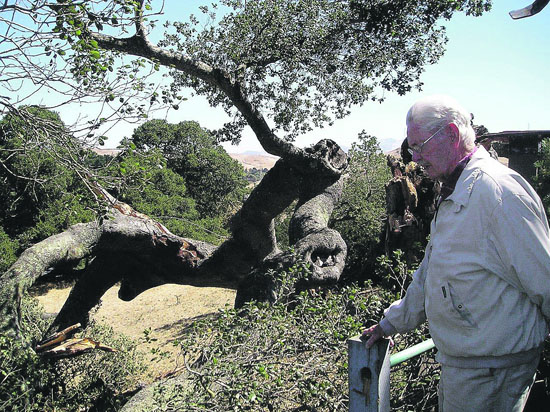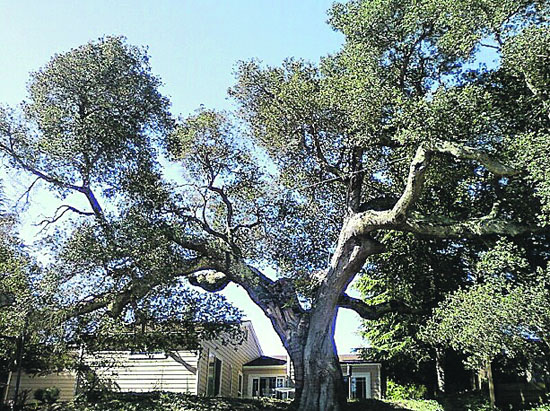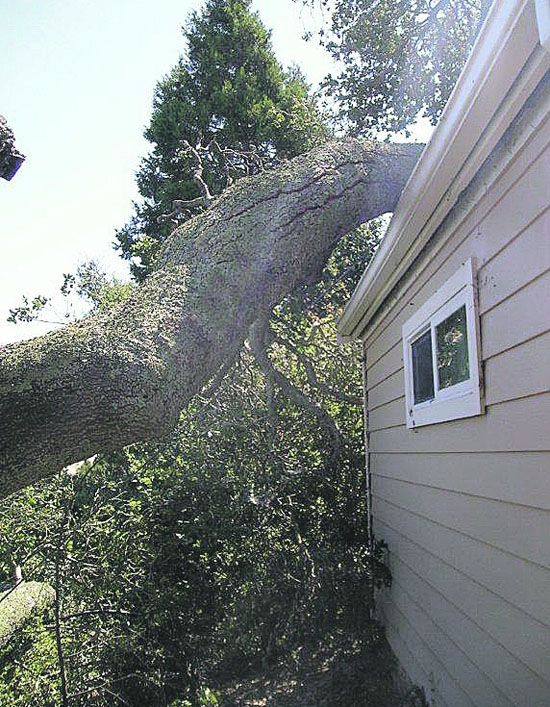| | Published September 14th, 2011
| Centuries Old Moraga Oak Falls
| | Cathy Dausman |  | | Homeowner Bob Muller looks at the damage caused by the
downed coast live oak Photo Cathy Dausman
|
A Moraga tree, that was standing when Junipero Serra was born, has died of natural causes. The 300-plus year old coast live oak on a slope behind homes on Ascot Drive broke apart the night of August 29. The tree was on land behind neighbors Bob Muller, Verna Osborn and Jeff Bartak. Although Osborn missed the event ("I slept right through it," she says) Muller and Bartak heard the racket. "It sounded like a thunder clap," said Muller.
 Bartak's house was hit by a limb along his bedroom roof. He was in the kitchen at the time, but says he heard a guttural roar like a freight-train and felt a thud that shook the place. "I knew what it was," he says. Half the tree (one limb) had fallen onto his back roof. Fifteen minutes later the other limb collapsed into Muller and Osborn's back yard. Their deck was destroyed, but again no one was hurt. "It could have done so much more damage," Bartak says. The tree was on homeowner association grounds; a tree service has already removed it. It will be chipped and used as ground cover throughout the association, says Ascot Highlands HOA manager Denise Di Gregorio.
Bartak's house was hit by a limb along his bedroom roof. He was in the kitchen at the time, but says he heard a guttural roar like a freight-train and felt a thud that shook the place. "I knew what it was," he says. Half the tree (one limb) had fallen onto his back roof. Fifteen minutes later the other limb collapsed into Muller and Osborn's back yard. Their deck was destroyed, but again no one was hurt. "It could have done so much more damage," Bartak says. The tree was on homeowner association grounds; a tree service has already removed it. It will be chipped and used as ground cover throughout the association, says Ascot Highlands HOA manager Denise Di Gregorio.
 But what a tree it was! It grew to 19 feet in circumference, nearly 30 feet in height with a leaf canopy of about 45 feet. Consulting arborist Tim Ghirardelli says coast oaks can live 400 to 800 years in the wild but disturbing the ground "minimally cuts the lifespan of a tree to one-quarter or one- third of its former potential...if they make it through at all. The younger the tree, the better it will survive through disturbances."
But what a tree it was! It grew to 19 feet in circumference, nearly 30 feet in height with a leaf canopy of about 45 feet. Consulting arborist Tim Ghirardelli says coast oaks can live 400 to 800 years in the wild but disturbing the ground "minimally cuts the lifespan of a tree to one-quarter or one- third of its former potential...if they make it through at all. The younger the tree, the better it will survive through disturbances."
 This tree originally had three main branches, which is common among coast oak. In 1998, a large branch on the north-east side of the tree broke off, leaving two main limbs. At the time the tree was thought to be over 300 years old with another five to eight years of life left. Ascot Highlands Homeowner Association paid to have its remaining two branches pinned with cable and braced with support poles. Bartok credits the group for "heroically" extending the tree's life.
This tree originally had three main branches, which is common among coast oak. In 1998, a large branch on the north-east side of the tree broke off, leaving two main limbs. At the time the tree was thought to be over 300 years old with another five to eight years of life left. Ascot Highlands Homeowner Association paid to have its remaining two branches pinned with cable and braced with support poles. Bartok credits the group for "heroically" extending the tree's life.
 The downed tree radically changed the view from Muller, Osborn and Bartak's backyards, allowing direct sunlight to flood their western exposure. Osborn says more traffic noise also filters up from Rheem Boulevard. She says she needs to "rethink [having] curtains" for their back windows. Bartak is saddened that the tree, which sheltered raccoons, owls, turkey, and red fox is gone. Yet he recently observed a covey of quail roosting around the fallen tree. "Every end," he says "is a new beginning."
The downed tree radically changed the view from Muller, Osborn and Bartak's backyards, allowing direct sunlight to flood their western exposure. Osborn says more traffic noise also filters up from Rheem Boulevard. She says she needs to "rethink [having] curtains" for their back windows. Bartak is saddened that the tree, which sheltered raccoons, owls, turkey, and red fox is gone. Yet he recently observed a covey of quail roosting around the fallen tree. "Every end," he says "is a new beginning."

|
 | | The grand oak in June of last year Photo Jeff Bartak
|  | | Half of the tree fell onto a back roof.
| |  Tree Ordinances: A Canopy of Rules in Lamorinda Tree Ordinances: A Canopy of Rules in Lamorinda
 By Cathy Dausman By Cathy Dausman
 Discussions about removing a fallen oak tree in Moraga led to questions about removing other trees from residential landscaping in the area. We contacted the Lafayette, Moraga and Orinda planning departments and the Moraga Orinda Fire District to understand the guidelines for removing trees. Discussions about removing a fallen oak tree in Moraga led to questions about removing other trees from residential landscaping in the area. We contacted the Lafayette, Moraga and Orinda planning departments and the Moraga Orinda Fire District to understand the guidelines for removing trees.
 "Trees are part of the character of Lafayette," says the city's Senior Planner, Greg Wolff. Given the "semi-rural" nature of Lamorinda, it's not surprising. All three cities have pages of documents which define native trees, explain when a tree can be removed, how it must be replaced and whether permits are required. "Trees are part of the character of Lafayette," says the city's Senior Planner, Greg Wolff. Given the "semi-rural" nature of Lamorinda, it's not surprising. All three cities have pages of documents which define native trees, explain when a tree can be removed, how it must be replaced and whether permits are required.
 Dead trees presenting a fire hazard or non-native small trees are the easiest to remove. In planning lingo, a tree is described in terms of its diameter and dripline. Tree diameter is measured at a certain height above grade (4.5 feet above grade in Lafayette and Orinda; 3 feet in Moraga), and described in inches at DBH (diameter at breast height). Its dripline is the outermost circle of a tree's vegetation, or canopy. A tree is considered small when its DBH is between four to six inches. Dead trees presenting a fire hazard or non-native small trees are the easiest to remove. In planning lingo, a tree is described in terms of its diameter and dripline. Tree diameter is measured at a certain height above grade (4.5 feet above grade in Lafayette and Orinda; 3 feet in Moraga), and described in inches at DBH (diameter at breast height). Its dripline is the outermost circle of a tree's vegetation, or canopy. A tree is considered small when its DBH is between four to six inches.
 The City of Lafayette's website lists native trees as seven species of oak, plus buckeye, madrone and bay trees. Moraga's Assistant Planner, Kelly Suronen, says indigenous trees in Moraga include the bay, oak, redwood, toyan and knob cone pine. The City of Lafayette's website lists native trees as seven species of oak, plus buckeye, madrone and bay trees. Moraga's Assistant Planner, Kelly Suronen, says indigenous trees in Moraga include the bay, oak, redwood, toyan and knob cone pine.
 Conversely, Orinda Associate Planner Scott Pacheco, AICP, says the plants on the disallowed vegetation list (containing 30 entries) may be removed without a permit process, because of their flammability. Conversely, Orinda Associate Planner Scott Pacheco, AICP, says the plants on the disallowed vegetation list (containing 30 entries) may be removed without a permit process, because of their flammability.
 Fire Marshall Mike Mentink says MOFD is mostly concerned with dead trees and the hazards they present. He talks about how Lamorinda's topography and weather patterns transforms dry vegetation into ladder fuel for wildfires. But Mentink stops short of recommending tree removal; instead suggesting "limbing up" (pruning lower limbs) trees. The trunks of fallen trees can often be left in place once its fuel (the small limbs) is removed. Fire Marshall Mike Mentink says MOFD is mostly concerned with dead trees and the hazards they present. He talks about how Lamorinda's topography and weather patterns transforms dry vegetation into ladder fuel for wildfires. But Mentink stops short of recommending tree removal; instead suggesting "limbing up" (pruning lower limbs) trees. The trunks of fallen trees can often be left in place once its fuel (the small limbs) is removed.
 After obtaining a permit and removing the tree, a homeowner may still need to replace it in kind. Lafayette code requires two 15-gallon [container] trees of the same genus or an approved substitute as replacement for each six inch tree removed. Orinda specifies that tree replacements be native variety and of at least three-quarter-inch diameter, but allows one-third of any replacements to be done in shrubs. Suronen says Moraga has no requirements for replacing cut trees; but does encourage the planting of native species. She says the Town's Design Guidelines (http://tinyurl.com/3dglht8) contains planting palettes and a drought tolerant, fire resistant native tree and shrub list. After obtaining a permit and removing the tree, a homeowner may still need to replace it in kind. Lafayette code requires two 15-gallon [container] trees of the same genus or an approved substitute as replacement for each six inch tree removed. Orinda specifies that tree replacements be native variety and of at least three-quarter-inch diameter, but allows one-third of any replacements to be done in shrubs. Suronen says Moraga has no requirements for replacing cut trees; but does encourage the planting of native species. She says the Town's Design Guidelines (http://tinyurl.com/3dglht8) contains planting palettes and a drought tolerant, fire resistant native tree and shrub list.
 Tree code information by city is available online: Tree code information by city is available online:
 Moraga: http://tinyurl.com/3sfdrab Moraga: http://tinyurl.com/3sfdrab
 (title 12, chapter 12, articles 1-4) (title 12, chapter 12, articles 1-4)
 Orinda: http://www.cityoforinda.org Orinda: http://www.cityoforinda.org
 (codes, title 17, chapter 17.21) (codes, title 17, chapter 17.21)
 Lafayette: http://tinyurl.com/3hfqko2 Lafayette: http://tinyurl.com/3hfqko2
 (title 6, part 4, chapters 6-17) (title 6, part 4, chapters 6-17) |
| | | | | | Advertisement | | |
| | | print story
Before you print this article, please remember that it will remain in our archive for you to visit anytime.
download pdf
(use the pdf document for best printing results!) | | | Comments | | |
| | | | | | | | | | | | | | | | |




